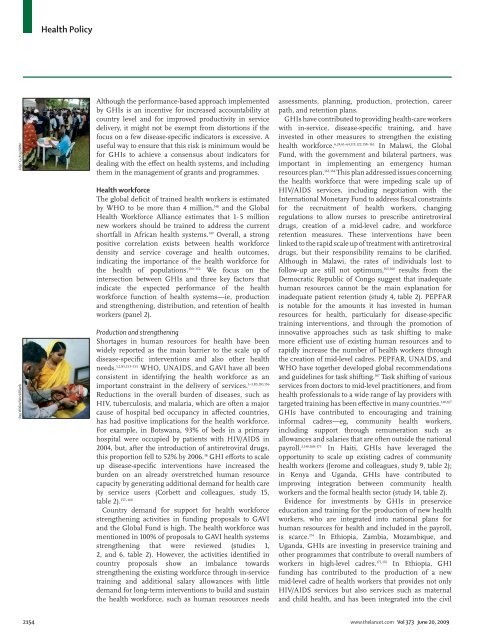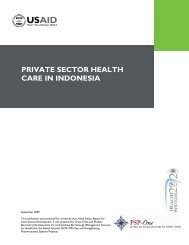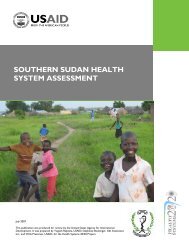An assessment of interactions between global ... - ResearchGate
An assessment of interactions between global ... - ResearchGate
An assessment of interactions between global ... - ResearchGate
Create successful ePaper yourself
Turn your PDF publications into a flip-book with our unique Google optimized e-Paper software.
Health Policy<br />
Ray Witlin/World Bank Allan Gichigi/IRIN<br />
Although the performance-based approach implemented<br />
by GHIs is an incentive for increased accountability at<br />
country level and for improved productivity in service<br />
delivery, it might not be exempt from distortions if the<br />
focus on a few disease-specific indicators is excessive. A<br />
useful way to ensure that this risk is minimum would be<br />
for GHIs to achieve a consensus about indicators for<br />
dealing with the effect on health systems, and including<br />
them in the management <strong>of</strong> grants and programmes.<br />
Health workforce<br />
The <strong>global</strong> deficit <strong>of</strong> trained health workers is estimated<br />
by WHO to be more than 4 million, 148 and the Global<br />
Health Workforce Alliance estimates that 1·5 million<br />
new workers should be trained to address the current<br />
shortfall in African health systems. 149 Overall, a strong<br />
positive correlation exists <strong>between</strong> health workforce<br />
density and service coverage and health outcomes,<br />
indicating the importance <strong>of</strong> the health workforce for<br />
the health <strong>of</strong> populations. 150–152 We focus on the<br />
intersection <strong>between</strong> GHIs and three key factors that<br />
indicate the expected performance <strong>of</strong> the health<br />
workforce function <strong>of</strong> health systems—ie, production<br />
and strengthening, distribution, and retention <strong>of</strong> health<br />
workers (panel 2).<br />
Production and strengthening<br />
Shortages in human resources for health have been<br />
widely reported as the main barrier to the scale up <strong>of</strong><br />
disease-specific interventions and also other health<br />
needs. 1,2,85,153–155 WHO, UNAIDS, and GAVI have all been<br />
consistent in identifying the health workforce as an<br />
important constraint in the delivery <strong>of</strong> services. 1–3,85,110,156<br />
Reductions in the overall burden <strong>of</strong> diseases, such as<br />
HIV, tuberculosis, and malaria, which are <strong>of</strong>ten a major<br />
cause <strong>of</strong> hospital bed occupancy in affected countries,<br />
has had positive implications for the health workforce.<br />
For example, in Botswana, 93% <strong>of</strong> beds in a primary<br />
hospital were occupied by patients with HIV/AIDS in<br />
2004, but, after the introduction <strong>of</strong> antiretroviral drugs,<br />
this proportion fell to 52% by 2006. 38 GHI efforts to scale<br />
up disease-specific interventions have increased the<br />
burden on an already overstretched human resource<br />
capacity by generating additional demand for health care<br />
by service users (Corbett and colleagues, study 15,<br />
table 2). 157–160<br />
Country demand for support for health workforce<br />
strengthening activities in funding proposals to GAVI<br />
and the Global Fund is high. The health workforce was<br />
mentioned in 100% <strong>of</strong> proposals to GAVI health systems<br />
strengthening that were reviewed (studies 1,<br />
2, and 6, table 2). However, the activities identified in<br />
country proposals show an imbalance towards<br />
strengthening the existing workforce through in-service<br />
training and additional salary allowances with little<br />
demand for long-term interventions to build and sustain<br />
the health workforce, such as human resources needs<br />
<strong>assessment</strong>s, planning, production, protection, career<br />
path, and retention plans.<br />
GHIs have contributed to providing health-care workers<br />
with in-service, disease-specific training, and have<br />
invested in other measures to strengthen the existing<br />
health workforce. 6,24,61–64,113,122,158–162 In Malawi, the Global<br />
Fund, with the government and bilateral partners, was<br />
important in implementing an emergency human<br />
resources plan. 163,164 This plan addressed issues concerning<br />
the health workforce that were impeding scale up <strong>of</strong><br />
HIV/AIDS services, including negotiation with the<br />
International Monetary Fund to address fiscal constraints<br />
for the recruitment <strong>of</strong> health workers, changing<br />
regulations to allow nurses to prescribe antiretroviral<br />
drugs, creation <strong>of</strong> a mid-level cadre, and workforce<br />
retention measures. These interventions have been<br />
linked to the rapid scale up <strong>of</strong> treatment with antiretroviral<br />
drugs, but their responsibility remains to be clarified.<br />
Although in Malawi, the rates <strong>of</strong> individuals lost to<br />
follow-up are still not optimum, 165,166 results from the<br />
Democratic Republic <strong>of</strong> Congo suggest that inadequate<br />
human resources cannot be the main explanation for<br />
inadequate patient retention (study 4, table 2). PEPFAR<br />
is notable for the amounts it has invested in human<br />
resources for health, particularly for disease-specific<br />
training interventions, and through the promotion <strong>of</strong><br />
innovative approaches such as task shifting to make<br />
more efficient use <strong>of</strong> existing human resources and to<br />
rapidly increase the number <strong>of</strong> health workers through<br />
the creation <strong>of</strong> mid-level cadres. PEPFAR, UNAIDS, and<br />
WHO have together developed <strong>global</strong> recommendations<br />
and guidelines for task shifting. 167 Task shifting <strong>of</strong> various<br />
services from doctors to mid-level practitioners, and from<br />
health pr<strong>of</strong>essionals to a wide range <strong>of</strong> lay providers with<br />
targeted training has been effective in many countries. 140,167<br />
GHIs have contributed to encouraging and training<br />
informal cadres—eg, community health workers,<br />
including support through remuneration such as<br />
allowances and salaries that are <strong>of</strong>ten outside the national<br />
payroll. 2,140,168–173 In Haiti, GHIs have leveraged the<br />
opportunity to scale up existing cadres <strong>of</strong> community<br />
health workers (Jerome and colleagues, study 9, table 2);<br />
in Kenya and Uganda, GHIs have contributed to<br />
improving integration <strong>between</strong> community health<br />
workers and the formal health sector (study 14, table 2).<br />
Evidence for investments by GHIs in preservice<br />
education and training for the production <strong>of</strong> new health<br />
workers, who are integrated into national plans for<br />
human resources for health and included in the payroll,<br />
is scarce. 174 In Ethiopia, Zambia, Mozambique, and<br />
Uganda, GHIs are investing in preservice training and<br />
other programmes that contribute to overall numbers <strong>of</strong><br />
workers in high-level cadres. 175,176 In Ethiopia, GHI<br />
funding has contributed to the production <strong>of</strong> a new<br />
mid-level cadre <strong>of</strong> health workers that provides not only<br />
HIV/AIDS services but also services such as maternal<br />
and child health, and has been integrated into the civil<br />
2154 www.thelancet.com Vol 373 June 20, 2009
















